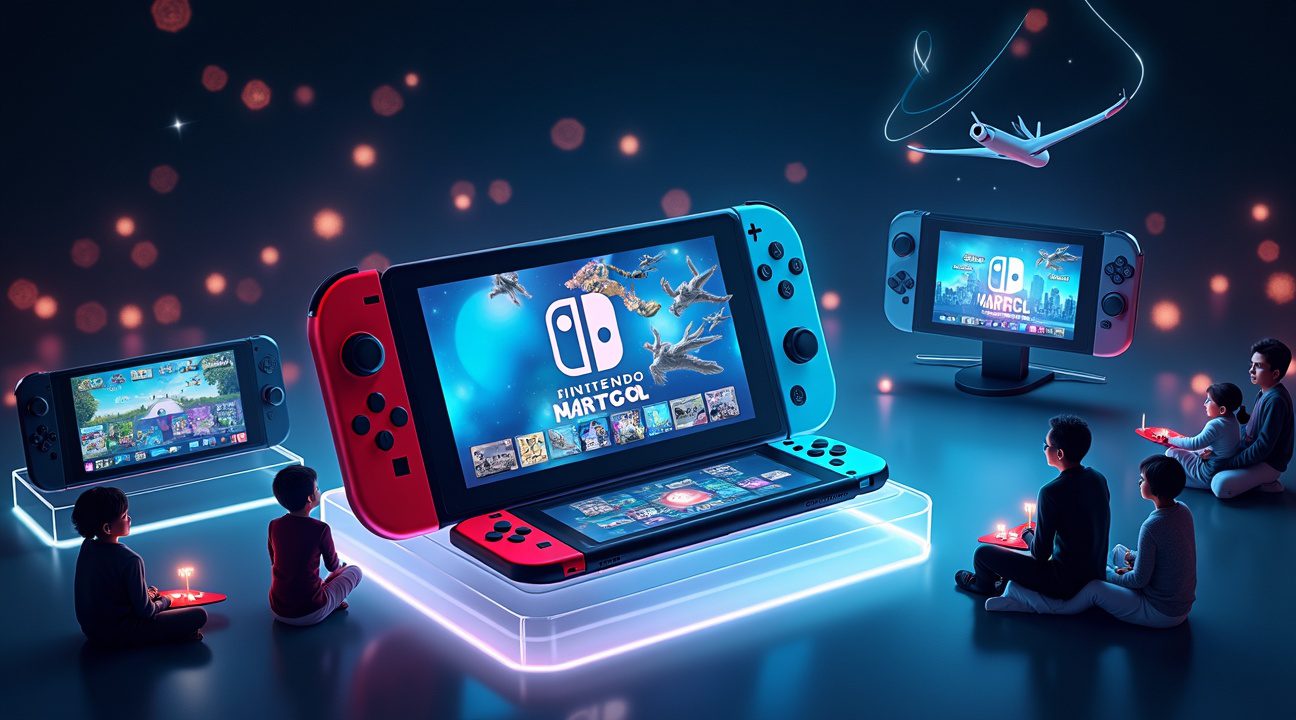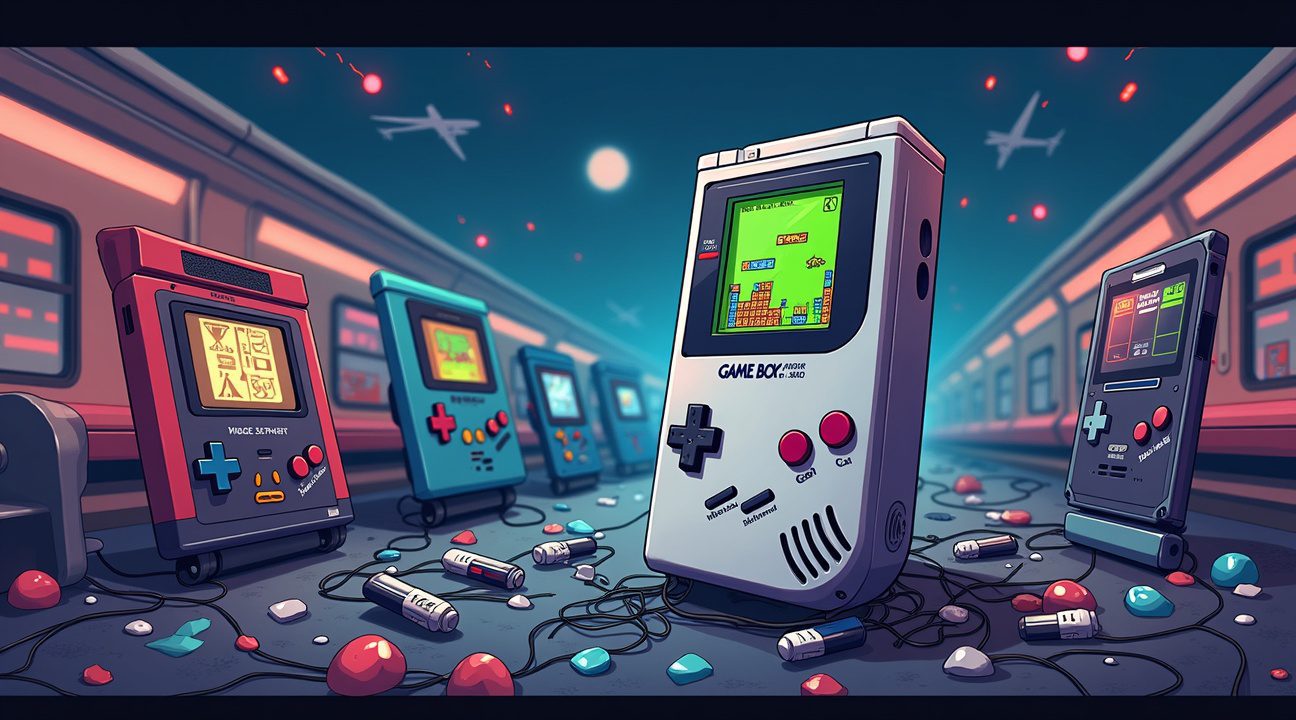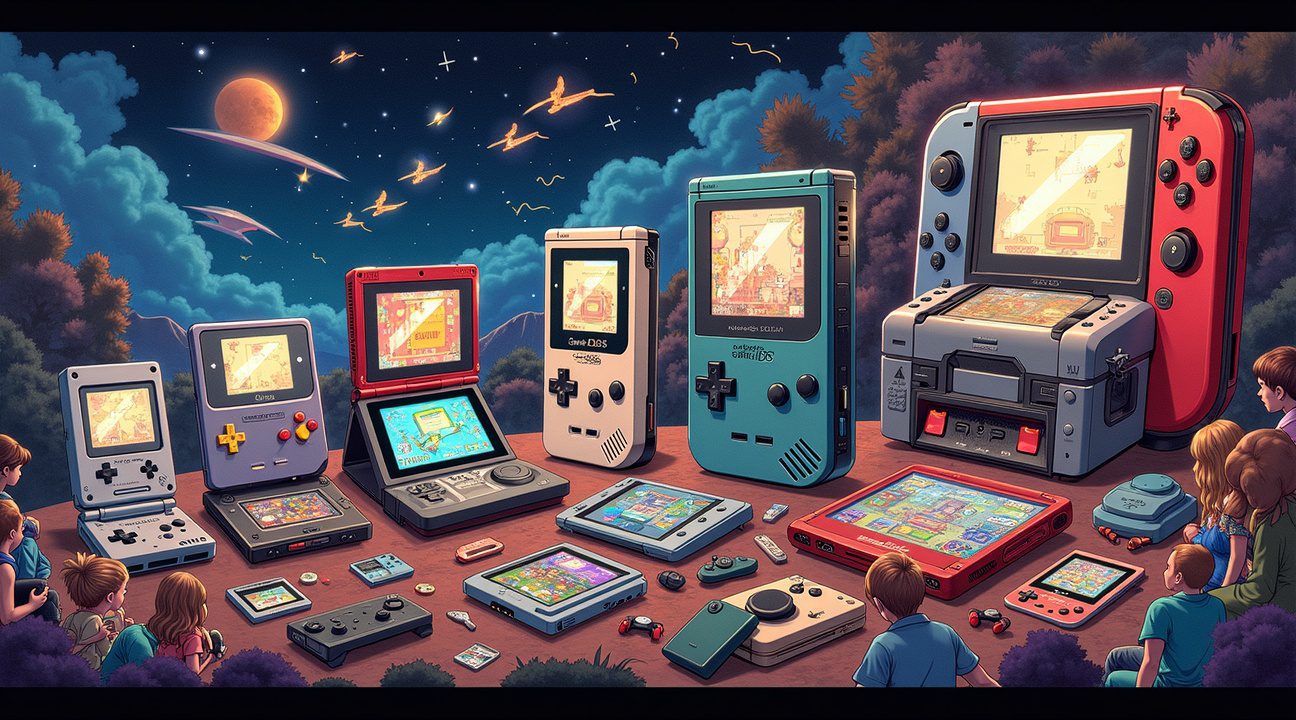Handheld consoles fundamentally transformed gaming by creating the hybrid category that bridges portable and home gaming experiences, with the Nintendo Switch’s 152.1 million units sold establishing it as a top-three console of all time. The success of handhelds from the original Game Boy’s 118.7 million units to modern devices like the Steam Deck proves that portable gaming has evolved from a niche market into a mainstream entertainment force that competes directly with traditional home consoles.
Key Takeaways
- Market dominance through hybrid innovation: The Nintendo Switch redefined console boundaries by seamlessly combining handheld portability with home console gaming, proving that players no longer need to choose between power and portability.
- Demographic expansion beyond traditional gamers: Handheld consoles opened gaming to new audiences including commuters, casual players, and educational users through accessible interfaces like touch controls and simplified gameplay mechanics.
- Iconic franchises born from portable platforms: Major gaming series like Pokémon, Tetris, and Brain Age found their perfect home on handhelds, creating experiences that couldn’t exist on traditional home consoles.
- Technological advancement through competition: Fierce rivalry between manufacturers drove rapid innovation in battery life, screen technology, wireless connectivity, and backward compatibility features that preserve gaming heritage.
- Cultural shift to portable entertainment: Handhelds transformed gaming from a home-bound activity into an anywhere, anytime experience that now influences how people consume all forms of digital entertainment.
Nintendo Switch Blazes Trail as 152.1 Million Units Sold Makes It a Top-Three Console of All Time
I can confidently say that Nintendo Switch has fundamentally transformed the gaming landscape since its 2017 launch. With an impressive 152.1 million units sold by 2024, this hybrid console has secured its place among the top-three best-selling consoles in gaming history. The Switch didn’t just succeed—it redefined what a gaming console could be.
Breaking Down Traditional Console Boundaries
The Switch accomplished something I’ve rarely seen in gaming: it completely blurred the line between handheld and home consoles. Its innovative hybrid design allows players to seamlessly transition from docked console gaming on their TV to portable play with detachable Joy-Con controllers. This flexibility addresses modern gaming preferences where players want options for how and where they experience their favorite titles.
What makes the Switch particularly remarkable is how it solved the age-old compromise between power and portability. Instead of forcing players to choose between full console experiences and mobile gaming, Nintendo created a device that delivers both. The detachable controllers add another layer of versatility, enabling local multiplayer gaming anywhere.
Competition and Market Evolution
Valve’s entry into this space with the Steam Deck has proven that Nintendo’s hybrid approach resonated beyond their traditional audience. The Steam Deck sold 3.7 million units by 2024, bringing AAA PC gaming into a portable format. This device appeals to enthusiasts who want to play their entire Steam libraries on-the-go, something that was previously impossible without compromising game complexity.
The handheld and hybrid console market has grown to be valued in the tens of billions as of 2024. Nintendo continues to dominate this space, but newer entrants like Valve have carved out significant niches. These modern hybrid devices owe their form factors and design philosophy to decades of handheld evolution, building upon lessons learned from the Game Boy through the 3DS.
I’ve observed how remote play and cloud gaming technologies have further expanded the possibilities for portable gaming. Players can now stream AAA titles from their home consoles or cloud services, making high-end gaming more accessible than ever before. This technological convergence has created an ecosystem where the boundaries between different gaming platforms continue to dissolve, offering unprecedented flexibility for how people engage with their favorite games.

Game Boy’s 118.7 Million Units Launched the Portable Gaming Revolution
Nintendo’s Game Boy fundamentally transformed the gaming landscape when it sold 118.7 million units globally, establishing the blueprint for portable gaming that continues to influence modern consoles. I’ve witnessed how this revolutionary device didn’t just create a new market segment – it redefined what gaming could be by making it truly accessible anywhere, anytime.
Technical Innovation and Market Dominance
The Game Boy’s success stemmed from smart engineering decisions that prioritized practicality over flashy features. Its 4-shade monochrome LCD screen might have seemed primitive compared to home consoles, but this choice delivered exceptional battery life that competitors couldn’t match. Nintendo bundled Tetris with the system, creating an irresistible package that appealed to players far beyond traditional gaming demographics.
Competition emerged quickly, with Sega’s Game Gear offering a backlit full-color screen that seemed technologically superior. However, the Game Gear’s 10.62 million units sold told a different story – superior specs meant nothing when the device drained batteries in just three hours compared to the Game Boy’s impressive 15-hour lifespan. The Atari Lynx faced similar challenges despite being the first color handheld in 1989, selling only 3 million units due to its premium pricing and power-hungry design.
The cartridge system became another crucial innovation that shaped portable gaming’s future. Unlike disc-based systems, cartridges offered instant loading, durability for mobile use, and compact storage that made building game libraries practical for handheld devices.
Competitive innovation drove rapid advancement in handheld technology, with each generation pushing boundaries in screen quality, processing power, and battery efficiency. The lessons learned from these early battles directly influenced today’s gaming devices, from smartphones to the Nintendo Switch.
The Nintendo DS later shattered all records by selling 154 million units worldwide, with the DS Lite model alone accounting for 93 million of those sales. This success proved that innovative features like dual screens and touch controls could create entirely new gaming experiences while maintaining the accessibility that made the Game Boy legendary.
Color screens eventually became standard as battery technology improved, but the Game Boy’s emphasis on gameplay over graphics established principles that continue to guide handheld design. Modern devices still balance performance with battery life, proving that Nintendo’s original philosophy remains relevant decades later.
The Game Boy’s impact extends beyond hardware sales to fundamentally changing how people interact with games. It proved that gaming could solve real-world problems like boredom during commutes, waiting periods, and travel. This accessibility transformed gaming from a home-bound activity into a constant companion.
Battery life remains a critical factor in handheld success, with manufacturers still struggling to balance power consumption against performance demands. The Game Boy’s 15-hour battery life seems almost impossible by today’s standards, yet it established expectations for portable gaming that persist across all modern devices.
Gaming preservation efforts have gained importance as these classic systems age, with digital preservation initiatives working to maintain access to handheld gaming history. The cartridge format that made these games possible also makes them vulnerable to time and wear.
Entertainment preferences shifted dramatically as handhelds proved that interactive experiences could compete with traditional media. The Game Boy’s success laid groundwork for mobile gaming’s eventual dominance over other entertainment forms.
Today’s gaming landscape continues to benefit from handheld console innovations through updated versions of classic titles and ongoing technological refinements that trace directly back to the Game Boy’s revolutionary design principles.

Gaming Goes Mainstream as Handhelds Reach New Demographics
Handheld consoles transformed gaming from a niche hobby into a mainstream entertainment medium by breaking down barriers that once limited access to interactive entertainment. The Game Boy revolutionized the industry by proving that people didn’t need to be tethered to televisions or dedicated gaming spaces to enjoy quality experiences. Suddenly, gaming became something people could do anywhere – on buses, in doctor’s offices, or during lunch breaks.
I’ve witnessed how portable systems like the Game Boy and Nintendo DS opened gaming to demographics that traditional home consoles couldn’t reach. Children gained independence from family TV schedules, while commuters discovered they could transform dead travel time into engaging entertainment. Parents found themselves picking up their kids’ handhelds during quiet moments, often becoming gamers themselves without realizing it.
Touch Interfaces and Educational Gaming Expand the Market
The Nintendo DS marked a pivotal shift in how people perceived gaming through its innovative dual-screen design and touch interface. These features made games more intuitive for newcomers who might have been intimidated by complex controller schemes. Brain Age challenged the notion that games were purely entertainment, positioning itself as a legitimate tool for mental fitness. Nintendogs brought virtual pet care to millions, attracting audiences who had never considered themselves gamers.
These casual-friendly titles demonstrated that video games could have positive impacts beyond entertainment, validating gaming as a worthwhile activity for people of all ages. The success of educational and lifestyle games on handhelds proved there was massive demand for interactive experiences that didn’t fit traditional gaming categories.
Handheld consoles also pioneered many features that modern gaming takes for granted. They established digital storefronts as viable distribution methods, allowing players to download games directly to their devices. Online multiplayer capabilities emerged on these portable platforms, connecting players across distances in ways that seemed impossible just years earlier.
The accessibility revolution sparked by handhelds created ripple effects throughout the industry. Gaming preferences shifted dramatically as portable experiences proved they could compete with traditional entertainment media. Developers began designing games specifically for short play sessions, creating bite-sized experiences perfect for busy lifestyles.
These portable systems normalized gaming as an everyday activity rather than a dedicated hobby requiring significant time commitments. By making gaming truly portable and accessible, handhelds expanded the medium’s reach far beyond its traditional boundaries, setting the stage for today’s mobile gaming phenomenon and proving that quality interactive entertainment could thrive anywhere.

Iconic Franchises Born from Handheld Success Stories
I’ve witnessed how handheld consoles didn’t just create a new gaming platform—they birthed entire franchises that shaped the industry forever. Several of today’s most beloved gaming series owe their existence and massive success to the unique opportunities that portable gaming provided. These systems proved that great games could thrive outside the traditional living room setup, often reaching audiences that home consoles couldn’t touch.
The Game-Changing Partnerships
Tetris stands as perhaps the most perfect example of how handheld success stories can transcend gaming itself. When Nintendo bundled this puzzle masterpiece with the original Game Boy, they created gaming magic that extended far beyond typical demographics. The simple yet addictive gameplay made Tetris the ideal companion for portable gaming, transforming commutes and waiting rooms into impromptu gaming sessions.
Pokémon’s arrival on Game Boy in 1996 changed everything I thought I knew about portable gaming’s potential. The franchise launched with Red and Blue versions, introducing a social element that made trading and battling with friends essential parts of the experience. This wasn’t just gaming’s positive impact on individuals—it created entire communities of players who carried their pocket monsters wherever they went.
Kirby also found his perfect home on Game Boy, with the pink puffball’s accessible gameplay style matching the handheld’s philosophy of gaming for everyone. The Legend of Zelda: Link’s Awakening proved that epic adventures could work brilliantly on smaller screens, delivering a full console-quality experience in portable form.
Evolution Through Hardware Generations
The Game Boy Advance elevated portable gaming with titles that pushed creative boundaries.
- Castlevania: Aria of Sorrow demonstrated how classic franchises could reinvent themselves for handheld audiences.
- Advance Wars introduced strategy gaming to players who might never have tried the genre on home consoles.
- Mario & Luigi pioneered the handheld RPG experience with humor and charm that felt perfectly suited to portable play sessions.
Nintendo’s DS/3DS era expanded handheld appeal even further with innovative touchscreen controls and dual-screen gameplay.
- Brain Age attracted non-traditional gamers with its mental fitness approach.
- Animal Crossing: Wild World created persistent virtual worlds that players could check in on throughout their day.
- Mario Kart DS brought competitive racing to portable platforms with local wireless multiplayer that transformed lunch breaks into racing tournaments.
- Pokémon X & Y later showcased how established franchises could evolve with new hardware capabilities while maintaining their core appeal.
Sony’s PSP made its own mark with exclusive games that pushed technical boundaries.
- God of War: Chains of Olympus delivered console-quality action on a portable system.
- Monster Hunter Freedom created a phenomenon that proved handheld consoles could support complex, long-form gaming experiences.
These titles demonstrated that handhelds could compete directly with home consoles in terms of production values and gameplay depth.
The success of these franchises on handheld platforms also influenced cross-platform development strategies. Many series that started as handheld exclusives eventually expanded to home consoles, while others maintained their portable focus to preserve the intimate gaming experience that made them special. Backwards compatibility features on newer systems ensured that beloved handheld classics remained accessible, preserving gaming history for future generations.
Independent developers found handheld consoles particularly welcoming to innovative ideas. The lower development costs and more accessible development tools allowed smaller studios to create games that might never have found success on home consoles. This indie gaming movement on handhelds laid groundwork for today’s thriving independent game development scene.
These iconic franchises proved that handheld gaming wasn’t just about convenience—it was about creating experiences that couldn’t exist anywhere else. The mobile nature of these systems enabled new types of social interaction, encouraged different play patterns, and opened gaming to demographics that traditional consoles had never reached.
Evolution Through Competition Drives Technological Innovation
I’ve watched portable gaming transform from simple monochrome displays to full-featured hybrid systems through decades of fierce competition. Each manufacturer pushed boundaries to differentiate their devices, creating a rapid succession of technological breakthroughs that fundamentally changed what gamers expected from handheld systems.
Color displays marked the first major leap forward when the Game Boy Color arrived, breaking the monopoly of green-tinted screens. This innovation opened doors for richer visual experiences, making portable games feel more immersive than ever before. The Game Gear and Game Boy Advance SP followed with backlit screens, solving the notorious problem of squinting under streetlights or desk lamps that had plagued earlier handhelds.
Dual screens and touch functionality revolutionized interaction patterns when the Nintendo DS launched, proving that innovation didn’t require more powerful processors alone. Touch controls made gaming accessible to demographics previously intimidated by complex button layouts, while the dual-screen setup enabled entirely new gameplay mechanics. Later, the Nintendo 3DS pushed visual boundaries even further with stereoscopic 3D displays that required no special glasses.
Backward Compatibility Preserves Gaming Heritage
Smart engineering decisions around compatibility extended the value proposition of each new system significantly. The Game Boy Color, Game Boy Advance, and Nintendo DS all supported previous generation cartridges, meaning gamers didn’t lose access to their existing libraries when upgrading. This approach built consumer confidence and encouraged adoption while preserving gaming preservation efforts through continued hardware support.
Competition from alternative platforms drove innovation beyond Nintendo’s ecosystem. The NEC TurboExpress offered unprecedented power by using identical cartridges to its home console counterpart, essentially creating the first truly portable home gaming experience. SNK’s Neo Geo Pocket brought fighting game excellence to portable platforms, targeting enthusiasts willing to pay premium prices for arcade-quality experiences on the go.
Contemporary advances in screen technology, battery efficiency, and wireless connectivity continue reshaping portable gaming expectations. Modern devices deliver console-quality visuals for hours without charging, while wireless multiplayer capabilities transform solitary gaming into social experiences. The Nintendo Switch represents the culmination of this evolutionary process, functioning seamlessly as both a portable and home console system.
These technological progressions have created unexpected cultural phenomena beyond their original gaming purposes. Video games shape individuals in ways that extend far beyond entertainment, with portable systems often serving as gateway devices for new generations of players. Educational applications, fitness tracking, and social networking features demonstrate how handhelds have evolved into multipurpose devices.
Collector markets have emerged around vintage handheld systems as gaming nostalgia drives demand for original hardware. Limited edition models, rare color variants, and complete-in-box systems command premium prices among enthusiasts seeking authentic retro experiences. This collector culture supports preservation efforts while validating the lasting impact these devices made on gaming history.
The competitive landscape that drove these innovations shows how market pressure accelerates technological development. Companies couldn’t rely on iterative improvements alone; they needed breakthrough features that justified new purchases. This dynamic created rapid advancement cycles that compressed decades of potential development into shorter timeframes, ultimately benefiting consumers through faster access to cutting-edge gaming technology.
Modern handheld gaming owes its sophistication to this constant competitive pressure, where each generation built upon previous achievements while introducing revolutionary new capabilities that redefined portable entertainment possibilities.

Revolutionary Impact on Gaming Culture and Industry Standards
Mobile gaming culture fundamentally redefined games as a portable activity, detaching them from traditional, home-bound entertainment setups. Handhelds transformed gaming from a stationary experience tied to living rooms into something that could happen anywhere – on buses, in cafeterias, or during breaks between activities. I’ve observed how this shift created entirely new social dynamics around gaming, where players could share experiences face-to-face while maintaining their individual gaming sessions.
The rise of mobile and digital ecosystems through handheld success laid crucial groundwork for modern digital storefronts and online multiplayer capabilities. Early handheld systems pioneered the concept of game libraries that existed beyond physical cartridges, particularly as connectivity became more sophisticated. These innovations directly influenced how players expect to purchase, download, and share games today, establishing patterns that would later define smartphone gaming and digital distribution platforms.
Expanding Gaming’s Reach and Appeal
Early handheld success helped drive the development of several key gaming categories:
- Casual games became more sophisticated and accessible through touch interfaces and simplified controls
- Educational games found their perfect platform through portable, personal devices that could be used in classrooms
- Puzzle and strategy games flourished due to their natural fit with shorter, more focused play sessions
- Social gaming emerged as handhelds allowed players to connect directly with friends nearby
Vintage handheld consoles have gained significant value among collectors, creating sustained interest in classic hardware that continues decades after their original release. I’ve seen rare Game & Watch units sell for hundreds of dollars, while limited edition Game Boy variants command premium prices. This collector market has inspired manufacturers to release retro-styled devices and has contributed to the preservation of gaming history through digital preservation efforts.
Continued advancements in battery and connectivity technology have ensured increasingly capable portable gaming experiences that rival traditional home consoles. Modern handhelds feature processing power that would have been unthinkable in early portable systems, along with wireless capabilities that enable seamless online play. These technological improvements have maintained the handheld gaming tradition while expanding what’s possible in portable formats.
The influence of handheld gaming culture extends beyond hardware into how people think about entertainment itself. Gaming preferences have shifted dramatically, with portable accessibility playing a major role in making interactive entertainment more appealing than passive media consumption. Handhelds proved that gaming could be both personal and social, immediate and deep, casual and engaging – contradictions that modern gaming continues to embrace.
Sources:
Wikipedia – Handheld game console
Record Head – The History of Handheld Game Consoles
Techedt – The Evolution of Handheld Gaming: How Culture and Technology Shaped the Market
Wikipedia – History of video game consoles
Business Insider – Game Boy at 30: How Nintendo’s Handheld Consoles Evolved Over the Years
Ambiq – The Evolution of Portable Console Gaming


